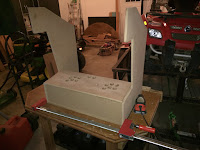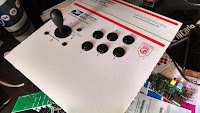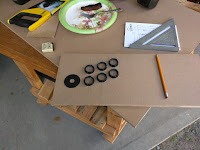So I was given this Neat Receipt scanner by a friend and I have to say I love it. Unfortunately they have moved away from hardware scanners and now focus more on cloud accounting software. I don't really use the software other than to create my files and this isn't a review of that anyway.
Couple of notes before I start. First I am sure doing this will probably void any warranties, so proceed at your own discretion. Second the "Face Down" sticker in my pictures was put there by me to remember which way the papers go through.
I started running into the issue of scanning pages written in gel ink. As I like gel ink pens for the crisp lines they make. Some times I would blank and scan them freshly written and not dry and some times I guess I was not waiting long enough for the ink to dry before running them through the scanner. The problem it caused was it left ink on the scanner bar inside and would then put lines on everything I scanned. After looking on the web the only thing I could find was to buy cleaning paper and run it through but I figured that wouldn't work.
So I figured out how to open the scanner and clean it myself and it really wasn't that difficult of a task so I thought I would share.
Firstly make sure you have the scanner unplugged from everything. Then flip the scanner upside down and there are 2 feet on the bottom. There are 3 screws to remove hidden under the feet. From the picture below there are 2 screws under the left foot and 1 under the right (upper half). See the arrow below.
Then once you have the screws removed I recommend grabbing the end without the USB connection and while applying inward presser on the top half and pulling down on the bottom half to start to open the casing. There are then 3 tab spots that need to be popped to fully open the case. (See the circles below) Be careful so as to not damage the scanner casing it should pry open gently.
Once you have all the tabs released the 2 halves will come apart. They are connected by a ribbon cable. (See circle below) It is your choice to pull the cable or not. You don't really need to if you don't want to. Just remember if you do to plug it back in before you put everything back together.
Once you have everything open you can now partly remove the roller and then get to the scanning glass to clean it. (See arrows below for where glass is) The roller easily removes on one post on the right the left does not. Once you remove that I recommend spraying a glass cleaner like Windex into a paper towel (not directly on/into the scanner) Then using the paper towel rub down the glass scanning surface.
Once you get the glass cleaned to your satisfaction you then reverse the process. First making sure the glass surface is dry. Then putting the roller back then reconnecting the ribbon cable if you removed it. Then slowly starting from one edge pressing the casing back together. You might have to push harder on some. Then you can re-insert the 3 screws in the bottom. Then go ahead and connect it and get back to scanning.















































